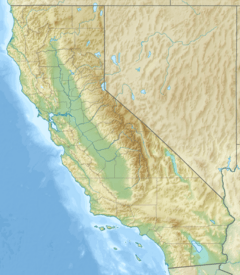Copper Creek (California) facts for kids
Quick facts for kids Copper Creek |
|
|---|---|
|
Location of the mouth in California
|
|
| Native name | Chwuloq'e |
| Other name(s) | Copper River |
| Country | United States |
| State | California |
| Region | Trinity County, Humboldt County |
| District | Six Rivers National Forest |
| City | Orleans (closest city) |
| Physical characteristics | |
| Main source | West Fork Copper Creek Johnson Spring 5,992 ft (1,826 m) |
| 2nd source | East Fork Copper Creek West Redina Peak 5,416 ft (1,651 m) |
| River mouth | Klamath River Near Orleans 398 ft (121 m) 41°35′26″N 123°31′20″W / 41.59056°N 123.52222°W |
| Length | 14 mi (23 km), South-North |
| Basin features | |
| River system | Klamath River |
| Basin size | 118 sq mi (310 km2) |
| Tributaries |
|
Copper Creek is a river in California, also known as the Copper River. Its native name is Chwuloq'e, which means chinook salmon. This creek flows into the larger Klamath River.
Copper Creek starts in the Klamath Mountains. It drains a narrow area of land about 120 square miles (310 km2). Long ago, a Hupa Native American village was located along Copper Creek. Later, in the 1850s, people searched for gold here. The creek got its name from the special peach-colored cliffs found along its lower parts.
Contents
Where Copper Creek Flows
Copper Creek begins as two main branches in the Six Rivers National Forest. These branches are in Trinity County. The West Fork is the bigger of the two.
West Fork's Journey
The West Fork starts at Johnson Spring. This spot is high up, about 5,992 feet (1,826 m) above sea level. From there, it flows north for about 16.5 miles (26.6 km). It then meets the East Fork.
East Fork's Journey
The East Fork begins on the side of West Redina Peak. It starts at an elevation of 5,416 feet (1,651 m). This branch flows northwest for about 14.2 miles (22.9 km) until it joins the West Fork.
Main Creek's Path
After the two forks meet, Copper Creek flows mostly north-northwest. It makes a loop to the southeast where Basin Creek joins it. Then, it turns north again, winding through a valley. Other smaller creeks, like Graham Creek and Lost Cow Creek, flow into it.
When Indian Creek joins, Copper Creek turns northwest. It crosses into Humboldt County. It then flows along the east side of Salmon Mountain. The river continues north-northwest through a canyon. This canyon has the special copper-colored cliffs that gave the creek its name. Finally, Little Copper Creek joins it. Copper Creek then empties into the Klamath River. This meeting point is about 3 miles (4.8 km) downstream from the town of Orleans. The Klamath River then flows another 40 miles (64 km) to reach the Pacific Ocean.
History of Copper Creek
Long ago, the Hupa tribe lived near Copper Creek and the Klamath River. They lived close to where Copper Creek flows into the Klamath. The Hupa people called the river Chwuloq'e. This name meant chinook salmon, which were very important to them. One Hupa village was located on the creek, within 5 miles (8.0 km) of its mouth.
Gold Rush and Naming
The name "Copper Creek" came about in 1851. This was during the California Gold Rush. Miners were traveling on the Klamath River, looking for gold. They found Copper Creek and noticed the unique copper-colored cliffs. These cliffs inspired them to give the creek its current name.
Mining's Impact
Over time, miners used a method called hydraulic mining. This method used powerful jets of water to wash away hillsides. They did this to find deeper gold deposits. This type of mining changed the natural environment of the creek. It also affected the salmon run, which is when salmon swim upstream to lay their eggs.


